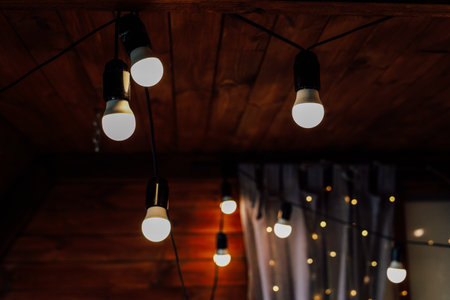Introduction: The Evolution of Home Lighting in India
Lighting has always played a pivotal role in Indian homes, shaping both ambience and functionality. Traditionally, Indian households relied on oil lamps (diyas), lanterns, and candles to brighten their spaces, especially during festivals like Diwali. These sources not only illuminated homes but also reflected deep-rooted cultural values, symbolising purity, prosperity, and hospitality. However, as lifestyles evolved and urbanisation spread across the country, modern lighting solutions such as LED bulbs, pendant lights, and smart lighting systems started gaining popularity. Today, Indian home interiors showcase a fascinating blend of age-old traditions and cutting-edge technology, with lighting choices reflecting the aspirations and preferences of contemporary families. This evolution in home lighting mirrors broader social changes—merging heritage aesthetics with practical needs for energy efficiency, convenience, and style.
2. Traditional Lighting: Timeless Charm & Cultural Significance
When it comes to Indian home interiors, traditional lighting options hold a special place in the hearts of many households. These fixtures are not just about illumination—they reflect centuries-old customs, regional artistry, and a sense of rootedness that modern lighting often struggles to emulate. Let’s explore some of the most popular traditional lighting options and their deep cultural significance.
Diyas: The Soul of Indian Festivities
Diyas, small oil lamps made of clay or brass, are synonymous with Indian culture. Especially during festivals like Diwali, diyas symbolise the triumph of light over darkness and good over evil. Their warm glow creates an inviting ambience, promoting peace and positivity in homes. Diyas are often hand-painted or adorned with ethnic designs, adding a personal touch to interior décor.
Lanterns: Versatile Heritage Accents
Lanterns—locally known as “kandils” or “fanuses”—come in myriad shapes, colours, and materials such as glass, metal, or fabric. Hung at entrances or courtyards, these lanterns not only provide functional lighting but also serve as eye-catching decorative elements. In many Indian regions, lanterns are integral to celebrations like Eid and Sankranti, enhancing the festive spirit and offering a warm welcome to guests.
Chandeliers: Royal Grandeur for Modern Maharajas
Chandeliers have long been associated with opulence in palaces and heritage homes across India. Crafted from crystal, brass, or even traditional jaali work, they bring an element of regal splendour to living rooms and dining areas. Today, many families choose vintage-inspired chandeliers to evoke nostalgia while maintaining contemporary comfort.
Comparison Table: Popular Traditional Lighting Options
| Lighting Option | Material | Cultural Significance | Ideal Placement |
|---|---|---|---|
| Diyas | Clay, Brass | Symbolises purity and auspiciousness during festivals | Pooja rooms, balconies, window sills |
| Lanterns (Kandils) | Metal, Glass, Fabric | Represents celebration and togetherness during major festivals | Entrances, patios, courtyards |
| Chandeliers | Crystal, Brass, Jaali work | Adds grandeur; reflects royal heritage and hospitality | Living rooms, dining halls |
Aesthetic Appeal & Deeper Meaning
The beauty of these traditional lighting options lies in their ability to blend functionality with symbolism. Whether you’re lighting a diya for Lakshmi Pooja or hanging a lantern for Diwali night, each piece tells a story—of family legacy, local craftsmanship, and timeless elegance that elevates any Indian home interior.
![]()
3. Modern Lighting Trends: Embracing Contemporary Solutions
Indian home interiors are experiencing a revolution with the introduction of modern lighting solutions that blend functionality, aesthetics, and technology. LED fixtures have become the new favourite across urban and semi-urban households, thanks to their energy efficiency, long life, and low maintenance. Unlike traditional tube lights or incandescent bulbs, LEDs come in a wide spectrum of colours and intensities, allowing Indian homeowners to create vibrant ambiances for different rooms—from warm yellows in living rooms to cool whites in kitchens. Smart lighting systems are also gaining popularity, especially among tech-savvy families in metros like Mumbai, Bangalore, and Delhi. These solutions offer remote control via smartphones or voice assistants such as Alexa and Google Home, enabling users to set schedules, adjust brightness, or switch moods with a single tap or command. Innovative designs are another hallmark of modern Indian lighting trends. Minimalist pendant lamps, geometric chandeliers, and concealed cove lighting add a contemporary touch while respecting space constraints typical in many Indian apartments. Designers often draw inspiration from global trends but give them an Indian twist—think brass-finished fixtures or motifs inspired by traditional jaali work but rendered in sleek, modern forms. The adaptability of these options caters to a variety of interior themes—from bold maximalism to understated elegance—making it easier for Indian homeowners to express their personalities through lighting. Ultimately, embracing modern lighting is about more than just illumination; it’s about enhancing the lifestyle experience while paying homage to India’s evolving design narrative.
4. Impact on Home Interiors: Aesthetic and Functional Perspectives
Lighting is not just about illumination; it shapes the character and functionality of every Indian home. The debate between traditional and modern lighting options becomes especially relevant in the context of India’s unique aesthetic sensibilities and practical needs. Let’s explore how these two approaches influence home interiors from both a visual and utilitarian angle.
Aesthetic Influence: Enhancing Ambiance and Décor
Traditional lighting, such as diyas, lanterns, and antique chandeliers, often brings a sense of nostalgia and cultural richness to Indian homes. These options typically incorporate intricate designs and warm glows that complement classic Indian décor elements like carved woodwork, ethnic textiles, and vibrant wall colours. They effortlessly create a cozy, inviting atmosphere—perfect for family gatherings or festive occasions.
In contrast, modern lighting solutions like LED panels, recessed spotlights, and smart lamps offer sleek minimalism that aligns well with contemporary interiors. Their clean lines, neutral tones, and adjustable brightness allow homeowners to experiment with open layouts and multifunctional spaces. Modern fixtures can highlight architectural features, add drama through focused beams, or provide subtle ambient effects for a sophisticated look.
Functional Perspective: Utility in Everyday Living
Functionally, traditional lighting may sometimes fall short in terms of energy efficiency or uniform coverage. Diyas and oil lamps are ideal for special rituals but less practical for daily use due to maintenance needs. Modern lighting solutions address these gaps with features like dimmers, motion sensors, and remote controls—bringing convenience that suits today’s fast-paced lifestyle.
Comparing Traditional vs Modern Lighting: Key Aspects
| Aspect | Traditional Lighting | Modern Lighting |
|---|---|---|
| Ambiance | Warm, inviting; complements ethnic décor | Sleek, versatile; enhances minimalist settings |
| Utility | Best for rituals & special occasions | Ideal for daily living; energy-efficient |
| Flexibility | Fixed illumination; limited adaptability | Customisable brightness & direction |
| Cultural Value | High; deep-rooted in Indian tradition | Evolving; fits modern lifestyle aspirations |
Finding the Balance in Indian Homes
The real magic happens when traditional and modern lighting are thoughtfully combined—preserving cultural identity while embracing innovation. Layering both types can create dynamic spaces that transition seamlessly from everyday utility to festive grandeur, reflecting the diverse spirit of Indian living.
5. Blending the Old and New: Harmonising Indian Aesthetics
Today’s Indian homeowners are embracing a beautiful marriage of tradition and modernity, especially when it comes to lighting choices. Rather than favouring one style over another, many are intentionally blending vintage charm with contemporary innovation to create spaces that feel both rooted and refreshed.
Creative Fusion in Everyday Spaces
Across India, families are pairing intricately designed brass or copper pendant lamps, reminiscent of temple diya lamps, with sleek LED strips and recessed ceiling lights. In living rooms, you might spot a traditional Rajasthani lantern hanging beside minimalist wall sconces, or ornate jaali (lattice) lamp shades illuminating a room furnished with modern couches. This creative mix not only enhances visual interest but also allows homeowners to express their personal stories and cultural pride.
Reflecting Local Sensibilities
The fusion is deeply influenced by regional tastes and traditions. For instance, homes in Kerala often feature hanging oil lamps (Nilavilakku) alongside energy-efficient LED bulbs, highlighting both the importance of heritage and sustainability. In Mumbai’s urban apartments, glass chandeliers with Mughal-inspired motifs are sometimes paired with geometric floor lamps, creating a sense of cosmopolitan elegance that still honours local roots.
Personalisation and Experimentation
This trend encourages experimentation—people mix antique wall brackets from local markets with smart lighting controlled via apps. They may drape fairy lights across hand-carved wooden beams or use dimmable spotlights to accentuate heirloom art pieces. Such personal touches transform ordinary interiors into unique sanctuaries that reflect each family’s journey through time and technology.
By thoughtfully harmonising traditional and modern lighting elements, Indian homeowners are crafting interiors that radiate warmth, celebrate diversity, and remain unmistakably Indian in spirit.
6. Cultural Considerations and Festive Lighting
Lighting holds profound cultural significance in Indian homes, especially during festivals and traditional ceremonies. From the twinkling diyas of Diwali to the vibrant lanterns of Eid and the colourful string lights for Christmas, every occasion brings a unique blend of illumination that reflects both heritage and evolving lifestyles.
The Spiritual Role of Light in Indian Traditions
In Indian culture, light symbolises purity, positivity, and the victory of good over evil. During religious rituals, oil lamps (diyas) and candles are lit to invoke blessings and create an auspicious atmosphere. These traditional lighting elements are not just decorative; they carry deep spiritual meaning and connect families with their cultural roots.
Modern Adaptations of Festive Lighting
Contemporary Indian homes have embraced modern lighting technologies without losing sight of tradition. LED strips, programmable fairy lights, and energy-efficient bulbs now complement or even replace conventional diyas during festivals. Homeowners opt for smart lighting solutions that allow them to change colours and patterns according to the festival being celebrated, adding a dynamic touch while maintaining cultural relevance.
Blending Heritage with Contemporary Trends
The fusion of old and new is especially visible during major celebrations. Many families integrate traditional brass lamps with modern pendant lights or use designer fixtures that resemble classic motifs but offer contemporary functionality. This seamless blending ensures that festive lighting remains both rooted in tradition and aligned with modern aesthetics, making Indian interiors truly unique.
Ultimately, lighting choices for festivals and ceremonies in India go beyond mere decoration—they are a conscious expression of identity, values, and the desire to honour heritage while embracing innovation. This balance is what gives Indian home interiors their distinctive festive charm.
7. Conclusion: Making the Right Choice for Indian Homes
When it comes to choosing between traditional and modern lighting options for Indian homes, the key lies in striking a harmonious balance that respects both practicality and cultural heritage. Indian interiors are a beautiful confluence of rich traditions and contemporary lifestyles, and lighting plays a pivotal role in amplifying this blend. For those who wish to honour tradition, incorporating elements like brass diyas, jharokha-style lamps, or intricate jaali patterns can infuse spaces with warmth and nostalgia. At the same time, embracing modern technology through energy-efficient LEDs, smart lighting controls, or minimalistic fixtures brings efficiency and convenience to everyday life.
To make the right choice, consider the unique character of your space, the purpose of each room, and the ambience you wish to create. Pay attention to local climatic conditions—opt for cooler lights in warmer regions and warmer hues where cosiness is desired. Think about layering: combine ambient lighting for general illumination, task lighting for functional areas such as kitchens or study corners, and accent lighting to highlight artworks or architectural features.
Ultimately, the best lighting solution is one that resonates with your family’s values while meeting daily needs. By thoughtfully blending traditional aesthetics with contemporary innovation, Indian homeowners can craft interiors that are both timeless and forward-looking—a true reflection of India’s evolving identity.


